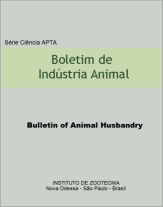Hierarchical and non-hierarchical clustering and artificial neural networks for thechracterization of groups of feedlot-finished male cattle
DOI:
https://doi.org/10.17523/bia.v72n1p41Keywords:
genetic groups, k-means method, Kohonen, Nellore, performance, sexual conditionAbstract
The individual experimental results of 1,393 feedlot-finished cattle of different genetic groups obtained at different research institutions were collected. Exploratory multivariate hierarchical analysis was applied, which permitted the division of cattle into seven groups containing animals with similar performance patterns. The following variables were studied: weight of the animal at feedlot entry and exit, concentrate percentage, time spent in the feedlot, dry matter intake, weight gain, and feed efficiency. The data were submitted to non-hierarchical k-means cluster analysis, which revealed that all traits should be considered. In addition to the variables used in the previous analysis, the following variables were included: dietary nutrient content, crude protein and total digestible nutrient intake, hot carcass weight and yield, fat coverage, and loin eye area. Using all of these data, structures of 3 to 14 groups were formed which were analyzed using Kohonen self-organizing maps. Specimens of the Nellore breed, either intact or castrated, were diluted among groups in hierarchical and non-hierarchical analysis, as well as in the analysis of artificial neural networks. Nellore animals therefore cannot be characterized as having a single behavior when finished in feedlots, since they participate in groups formed with animals of other Zebu breeds (Gyr, Guzerá) and with animals of European breeds (Hereford, Aberdeen Angus, Caracu) that exhibit different performance potentials.Downloads
Downloads
Published
Issue
Section
License
Os autores não serão remunerados pela publicação de trabalhos, pois devem abrir mão de seus direitos autorais em favor deste periódico. Por outro lado, os autores ficam autorizados a publicar seus artigos, simultaneamente, em repositórios da instituição de sua origem, desde que citada a fonte da publicação original seja Boletim de Indústria Animal. A revista se reserva o direito de efetuar, nos originais, alterações de ordem normativa, ortográfica e gramatical, com vistas a manter o padrão culto da língua e a credibilidade do veículo. Respeitará, no entanto, o estilo de escrever dos autores. Alterações, correções ou sugestões de ordem conceitual serão encaminhadas aos autores, quando necessário. Nesses casos, os artigos, depois de adequados, deverão ser submetidos a nova apreciação. As opiniões emitidas pelos autores dos artigos são de sua exclusiva responsabilidade. Todo o conteúdo deste periódico, exceto onde está identificado, está licenciado sob a Licença Creative Commons Attribution (CC-BY-NC). A condição BY implica que os licenciados podem copiar, distribuir, exibir e executar a obra e fazer trabalhos derivados com base em que só se dão o autor ou licenciante os créditos na forma especificada por estes. A cláusula NC significa que os licenciados podem copiar, distribuir, exibir e executar a obra e fazer trabalhos derivados com base apenas para fins não comerciais.













